Opinion
Scandal! Innuendo! Flipping! Kenny Schachter’s Inside Scoop on the May Art Auctions
Our columnist attended the evening sales in New York and got an earful—and eyeful—of market shenanigans to report.

Our columnist attended the evening sales in New York and got an earful—and eyeful—of market shenanigans to report.

I probably shouldn’t give it away, but New Jersey’s Newark Liberty International Airport is by far the easiest point of ingress and egress for New York City, ideal for beating customs queues, congestion, and, during the peak art seasons, the art crowd. It certainly worked for me last week when I flew in to cover the slate of contemporary art auctions—even if I literally stuck to the asphalt melting outside in the uncharacteristically scorching heat, which matched the extreme temperatures inside the city’s salesrooms.
Brancusi, whose head made a $57,000,000 record on a $35 million to $50 million estimate at Christie’s a day before the contemporary sales kicked off, once walked from Bucharest to Paris over the course of two months in 1904 as a symbolic pilgrimage to the then-epicenter of the art world. Today, we flock from far and wide to New York, the capital of cash.
Auctions are a bustling souk, a feral flip-fest for buying and reselling art. Pre-sale viewings, on the contrary, are the calm before the storm: often as airily vacant as a cathedral (or a temple with a till), they show the market’s contemplative side prior to its transformation into a trading pit. More frenzied than fairs, auctions are are detached from the underlying art, on a certain level, but there’s no better place to kick the tires and take it all in. It’s where I cut my teeth, first as a collector and then a dealer-to-dealer dealer.
Shortly before the sales, Colin Gleadell shrilled about auction guarantees in London’s Telegraph: “Without them, one shudders to think how thin these sales would be.” But despite guarantees up the gazoo, the auctions are swelling for good reason: consistently solid auction results over the course of the last year have contributed to an opening of the freeport floodgates, resulting in a near deluge of good art coming up for sale.
Guarantees are presales, but sales nevertheless—even if the players are an incestuous circle-jerk of insiders at the top level, including card-carrying club members Stevie Cohen, Dan Sundheim, David Geffen, David Martínez, Steve Wynn, and the Nahmad and Murgrabi families, among a small cadre of others.
Herewith, my investigatory report on last week’s sales. I’m not going to dwell on the oft-reported auction results much, but they were rock solid, resilient, and at or near the top expectations.
The outstanding collecting family of Emily and Jerry Spiegel, suffering internal strife (I know what that can feel like), choose to break up their collection—an art world epidemic, though it doesn’t bother me too much since I was the beneficiary of a sublime viewing experience. I could have happily died then and there in the Christie’s viewing room (that would have been something) amongst the Gober, Nauman, and Polke works alone. I suppose former Christie’s exec Bret Gorvy had similar feelings, considering that he and his new business partner Dominque Levy were said to have guaranteed a sizable portion of the works.
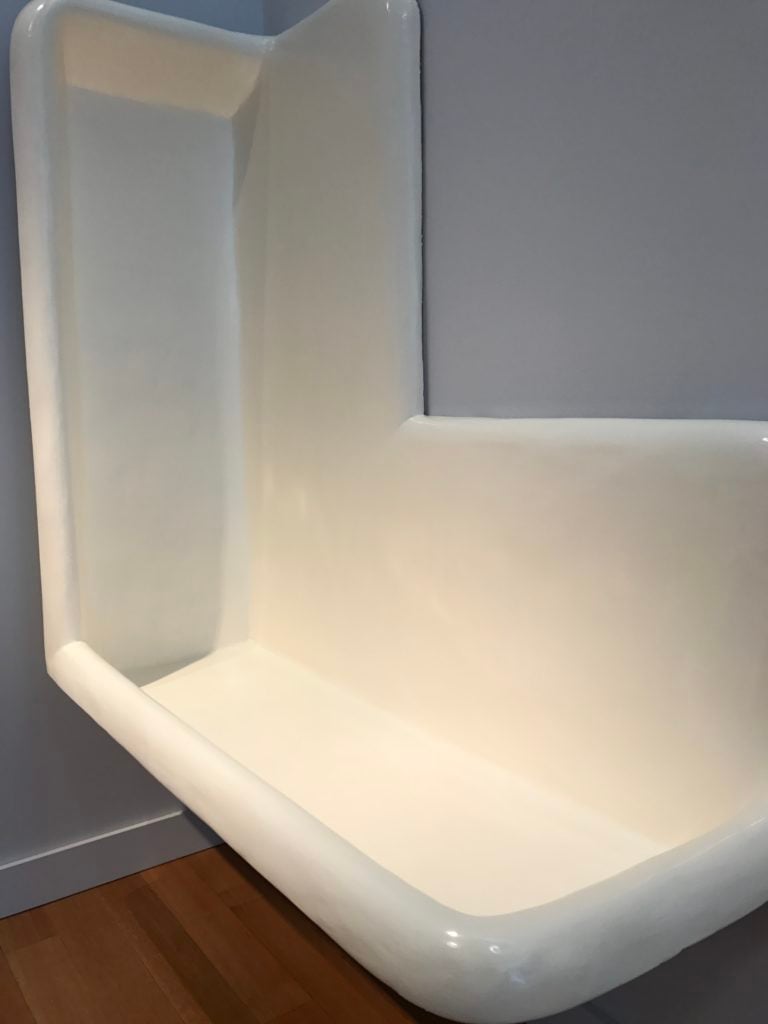
A Robert Gober sink at Christie’s. Courtesy of Kenny Schachter.
Gorvy, who avoided “gardening leave” after departing his high-profile auction perch, can still be found taking occasional potshots at his old nemesis, Sotheby’s, on his fabulous and widely watched Instagram account. I’d love to be privy to the contractual nature of his ongoing Christie’s affiliation (surely there is one). First loves die hard.
A sideshow within the main event of Christie’s evening sale was “Death in America: Selections from the Zadig and Voltaire Collection” (if you can call it a “collection”), in which the fashion company’s founder, Thierry Gillier, sold a group of 40 works. The occasion merely marked the birth of another disingenuous flipper, rather than the end of a meaningful body of thoughtfully gathered art. Unsurprisingly, a portion of the “Death in America” sale went to the art world’s pet cause, the environmental charity run by Leo DiCaprio.
Death didn’t make a killing. One of the only lots that did well, a copper cast by Rudolf Stingel (b. 1956), would have done even better had Gillier not turned down a more generous offer before the auction that exceeded the final hammer price. Another cast from same series, sold by spec-u-lector Françoise Odermatt, made even more the following sale. Stingel’s previous record of $4.7 million tumbled no less than three successive times over the course of two nights, landing at $10,551,000 for a daunting, melancholic self-portrait from 2006—an astounding sum for such an oversized canvas (15 feet in the long dimension).
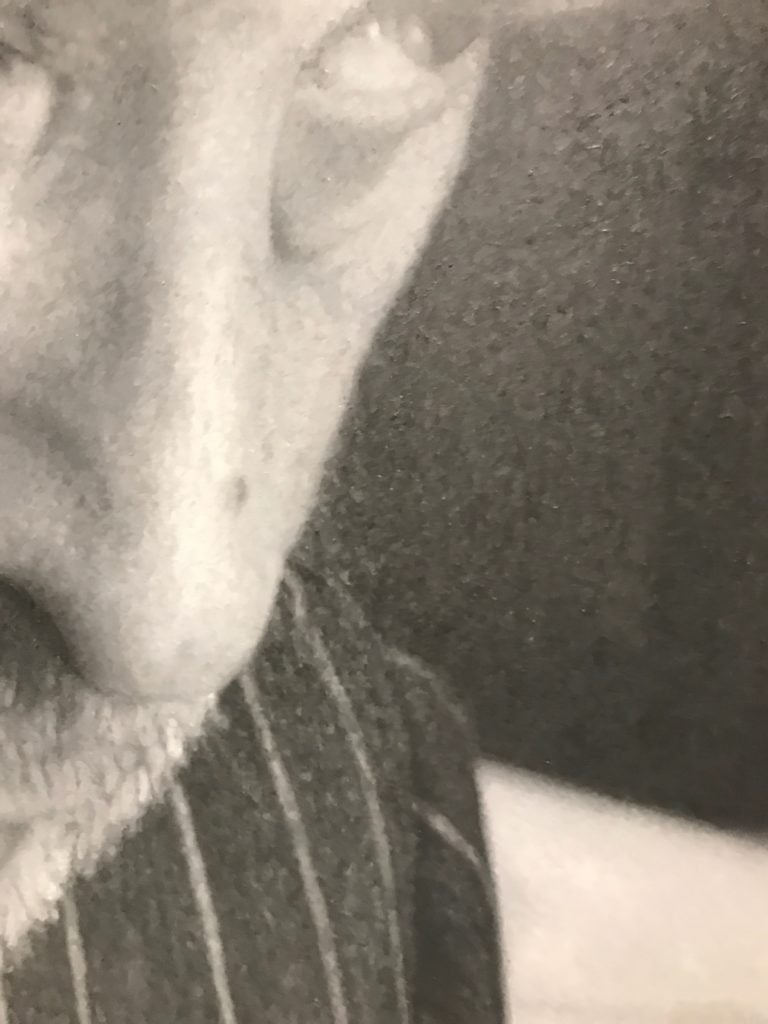
A detail of Rudolf Stingel’s Self Portrait at Christie’s. Courtesy of Kenny Schachter.
During the week, 10 Stingels on offer had a gross estimate of $23,380,000 to $33,270,000, and all but one sold; the grand total of $28,786,500 spent was smack in the middle of the range—that’s a lot of market absorption. Admittedly expectations were high, with a lot of pre-sale puffery, but the performance was strong, sane, and steady. In my estimation, Stingel is still relatively cheap compared to his peers, with similar levels of institutional support. In full disclosure, I’m a big fan and a participant in the market (as you could probably tell).
Compare that with Mark Grotjahn (b. 1968), who sold a painting in the same sale for $16,767,500 on a guarantee (from either Cohen or Sundheim, I haven’t gotten to bottom of it yet). Grotjahn garnered big prices with no bidding, and with such thin-on-ground activity, that I can’t foresee the recent speculative craziness lasting much longer. I also hear someone just reneged on a $15 million private deal.
Jean-Michel Basquiat’s La Hara, estimated at $22 million to $28 million, was sold by Cohen and guaranteed by Geffen (I told you). My trusty source Deep Pockets shared that Geffen’s pal Jimmy Iovine was about to pull the trigger on the deal but Geffen did an end run behind his back and poached the guarantee. Considering that former London gallerist Emily Tsingou snagged the work for $34,967,500, I can’t imagine Iovine was too amused by Geffen’s swift and hefty profit. What are (art world) friends for?
A few juicy asides: One friend was turned down for a paddle until his repeated protestations were accepted by the house—after all, he was suing Christie’s for non-payment, not the other way around. Also, on exiting the room, both Laurence Graff and Peter Brant were congratulated by Christies execs. Why? After some post-sale digging, I gathered that Graff bought Warhol’s Last Supper for $18,727,500 (est. $6 million – $8 million) and a Picabia for $3,367,500 (est. $1.5 million to $2 million); Brant, for his part, picked up Warhol’s Big Campbell’s Soup Can with Can Opener (Vegetable) for $27,500,000 (est. on request). The prices were small beans for the both of them.
I was told as a child, “If you have nothing nice to say, don’t say anything at all”—a lot of good that did—but with Phillips I’ll take the intermediate road and not get into too much detail. Except, that is, to say that they posted improved numbers with better-than-usual material, though I noticed at least one worse-for-wear work resurfacing from a recent sale at another house. With 17 out of 30 lots presold, it was more like a gallery exhibit than an auction (10 guarantees were in-house). Launching at 5 p.m. before Sotheby’s 7 p.m. sale that same evening, Phillips served up the art world’s equivalent of an early bird special, or kiddie matinee.
In the elevator for the previews in the oddly disconnected exhibition space, the operator bellowed that New York is a magnificent living piece of art. I thought for an instant that he was a relational-aesthetics artwork. As distracting as the monologue was, it could have been worse—last week Phillips had a captive audience when some patrons got stuck in the very same lift, screaming to be freed.
Upstairs, in the preview aerie, was David Hammons’s African American Flag from 1990. The artist is a frequent consignor to auction on his own account, and I wondered if the piece came from him. The wall around the artwork had so many nail punctures it resembled a junkie’s forearm—how many holes could it possibly take to hang a Hammons? They can’t even get that right.
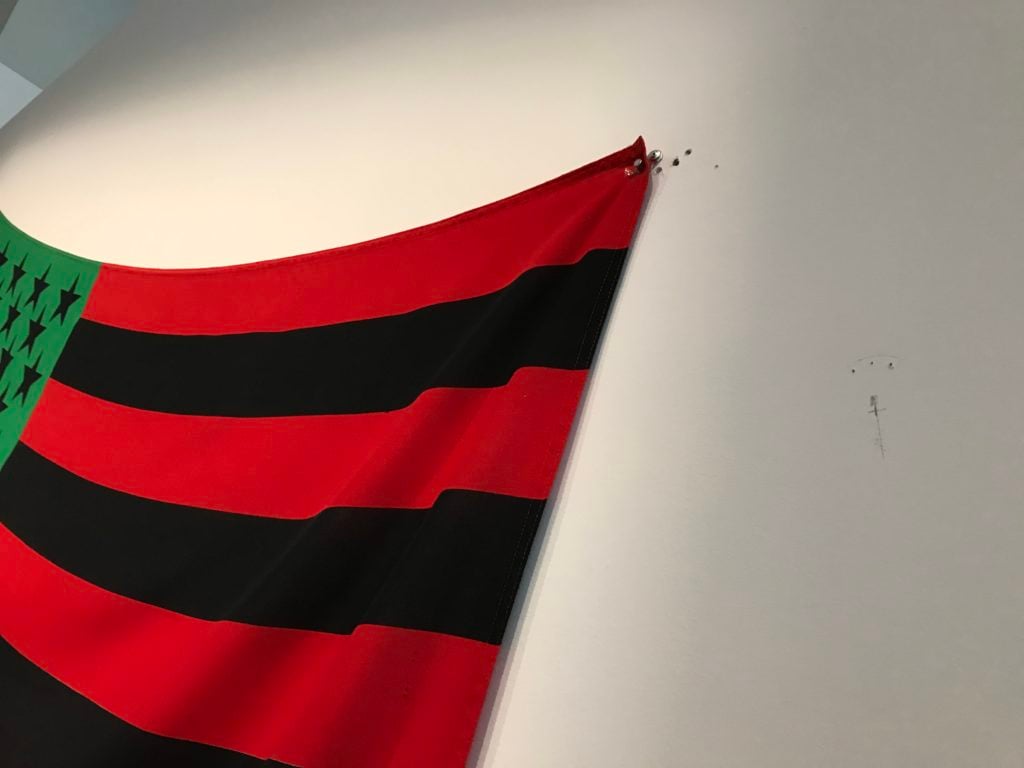
Holes in the wall surrounding David Hammons’s African American Flag. Courtesy of Kenny Schachter.
Phillips was willing to assure the sales of works in-house at that their own expense instead of through third-party funding, a far riskier approach than Sotheby’s and Christie’s. This is less a strategy to find success in bigger grosses, and more a concerted effort to buy market share. They’ll have a hell of a yard sale soon. I can at least hand this to Phillips: the scrappy house is assured second place in June’s London contemporary art sales among the big three—Christies already dropped out of the fray altogether.
Here’s some breaking news! Yusaku Maezawa did not pay $110,500,000 for the Basquiat, as has been widely reported. After selling Tom Wesselmann’s Smoker 21 for a hammer of around $2 million, his net was only $108,500,000. This I know for certain because Maezawa previously posted the Wesselmann in his explicit, Rich-Kids-of-Instagram-esque social media account some years ago.
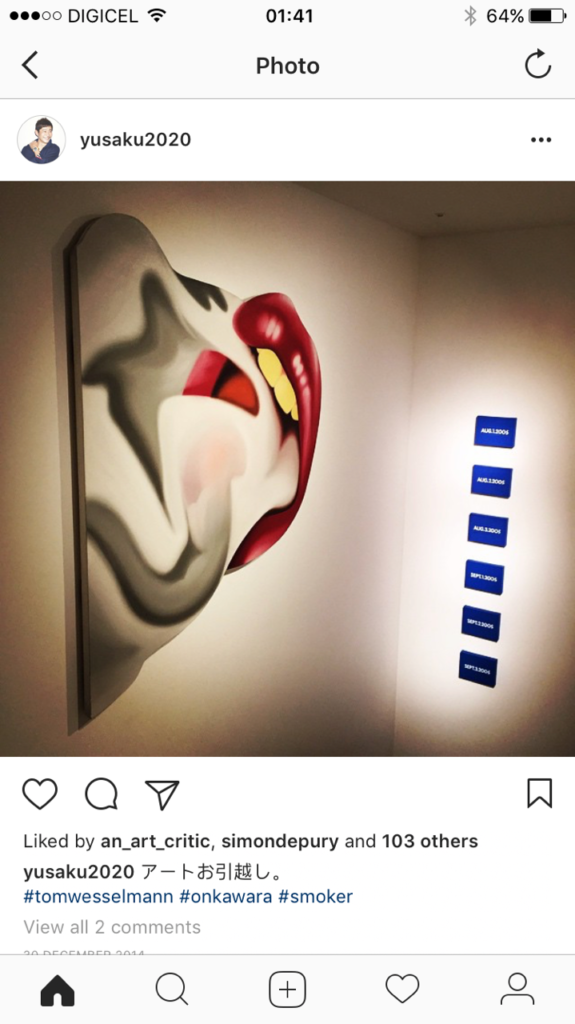
Yusaku Maezawa’s Instagram page. Image courtesy of Kenny Schachter.
Sadly, this Basquiat benchmark places a lens over the art that will forever shade and distort the way it looks—we all know it’s easier to talk about money than art. Equally stunning is that a few dollars worth of sticks, fabric, and pigment could go so far, whatever the impetus. In the direction we are heading, there will be no middle market in contemporary art soon.
Adrian Ghenie’s glum, nondescript painting The Second Presentation Room (est. $1 million – $1.5 million) sold for $2,172,500—there’s a sucker born every evening sale—and it has a back story that far exceeds the content of the work itself. Inconceivably, the artist has an auction record of $9 million at this nascent stage of his career and, equally outrageous, the artist had the audacity to call Sotheby’s to complain how misguided they were in estimating the work so low, since it’s a painting “assured to be in all his upcoming retrospectives and books.” That leaves me speechless (imagine that).
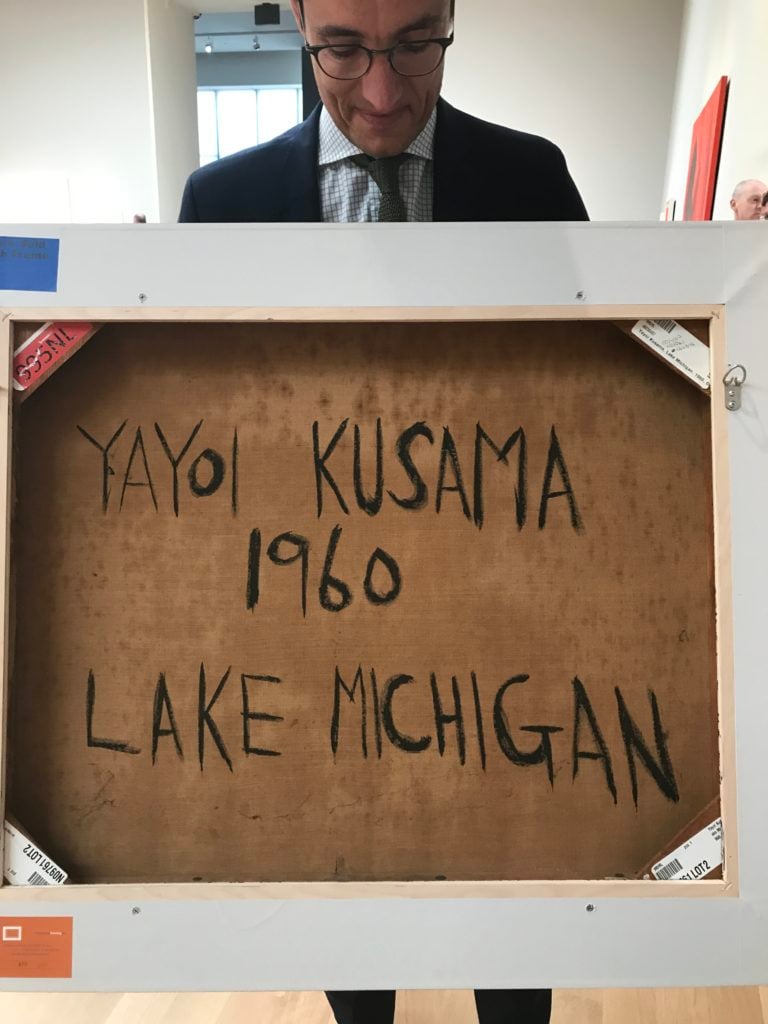
Yayoi Kusama’s Lake Michigan at Sotheby’s. Photo courtesy of Kenny Schachter.
Yayoi Kusama’s Lake Michigan, from 1960, fetched $5,300,000 on an estimate of $2 million to $3 million. One can admire her fluidity in capturing undulating motion so vividly in paint, but one should marvel even more that she’s still banging out her greatest hits at an alarming rate—maybe she post-dates them into the future—just to keep production in motion. At her age, bless her—and Gerhard Richter, too, with his 26 new paintings on view at the Ludwig in Cologne.
Lastly, when it comes to Sotheby’s, I can’t resist noting the chance constellation that appeared when I sat down at the sale: together with three bidders sitting directly behind and ahead of me, scattered across different rows, we created four links in an art-deal chain. Unbeknownst to all but me, my “friends” and I were all involved in selling the same piece of art (I won’t say which)—an art-dealer club sandwich with extra seed(iness) on top. The guy in the middle was actually the middle man (well, we all were in theory). I’m an unrepentant flipper of 30 years (!), but with some degree of forthrightness and integrity. Like drinking, one should flip responsibly.
As readers of my column might already know, “Slipped Disk” at 432 East 9th Street is a group show open through the 25th of May; the hours of operation are 10 a.m. to 6 p.m. Organized by Caio Twombly, son of artist and sculptor Alessandro (and grandson of Cy), this exhibition features my kids, Adrian and Kai, and Harry Solasz. They were searching for an unorthodox context and, boy, did they ever find it! A functioning, though archaic, chiropractic practice seemingly frozen in the amber of 1977. Caio is a brooding shaggy dog of an earnest art-history major, endearing as one of my own. (Just what I need, another one.)
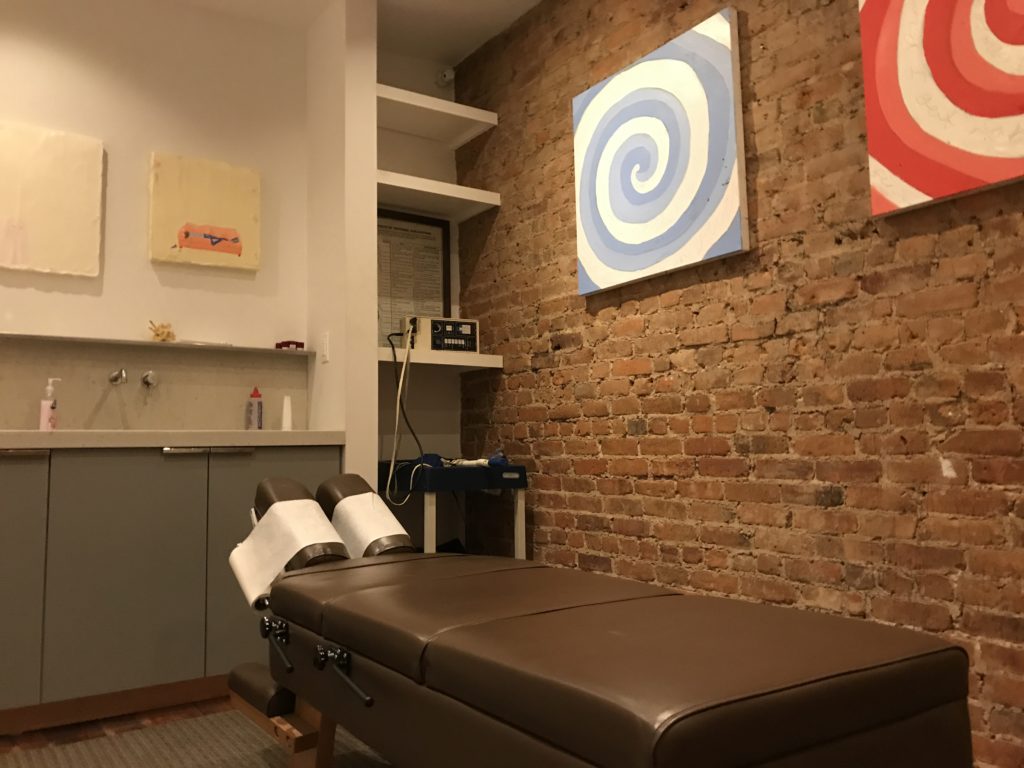
Kai Schachter’s Spiral (of time on my mind) and two small paintings by Adrian Schachter at Slipped Disk, 432 E. 9th St., through May 25th, 10am – 6pm. Courtesy of Kenny Schachter.
The apples don’t fall far from the knobby, twisted tree—they quickly sold four works before I could even raise the price! Adrian showed small narrative paintings practically smeared onto the canvas like frosting on cake, accompanied by such charming titles as babies in drawers to prevent crib death and woman with a twisted esophagus. Kai’s new paintings continued his quirky, barely legible process-oriented text abstractions with shards of figuration incorporating plants (and titles like potted pain II—I wonder where they get it from?). I grabbed a work by each before the proceedings began, but they sold one out from under me. Nice. I realized I could actually flip my own offspring’s art—call it payback! For pain and suffering, to begin with.
I found them all fast asleep in the middle of the next day after celebrating nearly selling out their show—I guess there’s nothing like being on the job, gallery hours be damned. But let me tell you, theirs is the only art I can deal, and I’m a lousy art dealer—it’s that good. We’ll also have a summer show together at Ibid Gallery in Los Angeles opening mid-July and up through August. I was bewildered and near tears (of relief) by their effort and focus. With ready access to more, I’m going to replenish my supply and move some product… or punish them. We, obviously, believe in art as a family business. See it, please!
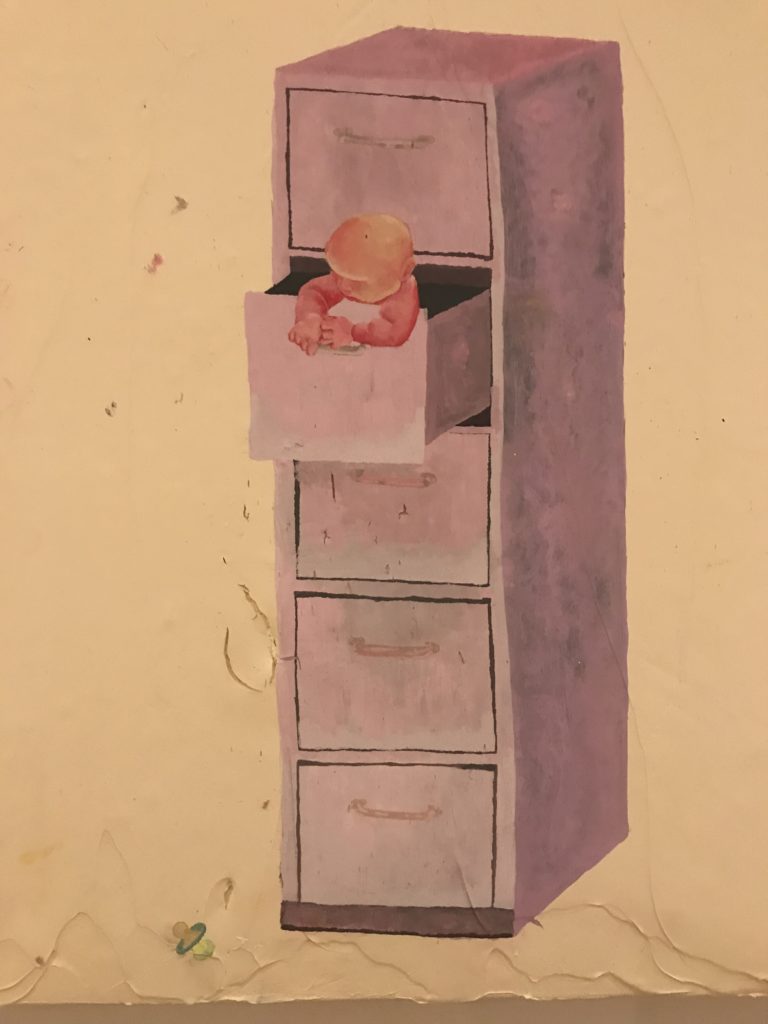
Adrian Schachter’s babies in drawers to prevent crib death. Courtesy of Kenny Schachter.
Speaking of which, Jerry Saltz moaned that a Cy Twombly painting that sold for $53 million—a figure some were idiotically disappointed with—would be swallowed into a freeport, never to see light again. But! There are plenty of great works of all stripes on view at a museum near you, gifted, loaned, or outright owned by institutions. A more efficient, fairer system than the laissez faire-ish art marketplace is nonexistent to date.
Like an art ostrich with my head buried at auction, I almost missed that the stock market and US presidency were simultaneously imploding as the auctions exploded. But at this mature stage of the contemporary art market, a bubble burst is a near impossibility due to its breadth and global reach. The hyperpriced art world we live in is hanging on every sales result—it’s only money, right? And lots of it. But my takeaway from the week is a robust market in rude health. Exiting a sale, Gagosian noted that there are more dire issues facing the world than buy-ins—but if the universe cared more about sell-through rates, and the underlying art, we’d all be safer and saner.
Capping off my frenetic trip was the good news that my plane ticket got upgraded. In the lounge back in Newark, I spied another gallerist who commented on the strength of the market based on our fare class. (Almost the level of bragadoccio as Maezawa’s Instagram account.) Boarding, the check-in attendant heard the word “painting” exchanged between me and the dealer and jumped in asking questions. What is this world coming to? I found out on the plane that Emily Tsinguou’s Basquiat buyer was new to the game, and particularly discrete—it’ll take further sleuthing to get to bottom of this.
As my oldest two children get their art careers in motion, the remaining two in London (Gabriel, 17, and Sage, 14) continue to tear it up, even after the infamous house fire. Deplaned, I came home to a crime scene of trash and empty liquor bottles strewn throughout the house. When is the next fair, biennial, auction, trade show? Please, anything, anywhere. Oh right, Basel, which should be great—see you there (early).